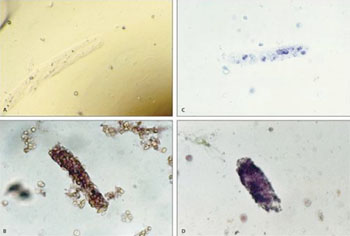Classical Microscopy Outperforms Automated Urine Analysis
By LabMedica International staff writers
Posted on 07 May 2014
The human eye using a microscope can be more accurate than automation when it comes to analyzing urine samples for signs of kidney damage. Posted on 07 May 2014
An automated urine analysis system can miss signs of kidney damage that can easily be identified by a trained observer looking through a compound microscope at the urine sample.

Image: Urinary Casts as viewed by microscopy (A) Hyaline cast (×200); (B) erythrocyte cast (×100 ); (C) leukocyte cast (×100) ; (D) granular cast (×100) (Photo courtesy of the American Family Physician).
A team of scientists at the University of Arizona (Phoenix, AZ, USA) investigated how well each approach, microscopy and automated analysis, was able to identify granular and muddy brown casts, tiny tube-like structures made of protein secreted by the kidney. Casts in the setting of kidney damage can help identify the underlying problem such as inflammation or infection, and counting them and identifying their characteristics and composition can provide important diagnostic and prognostic information.
Each of the 10 samples analyzed were from patients with acute kidney injury. A single person analyzed each urine sample, first by examining it under the microscope, and then with the automated IRIS 200 urinary analysis system (Iris Diagnostics; Chatsworth, CA, USA). The IRIS 200 system coded 70% of the samples as having no casts. All of the samples were classified as having few casts using manual microscopy. The samples that were automatically coded on IRIS 200 as having many casts were also coded as few by manual microscopy.
Natasha Sharda, MD, the lead investigator, said, “The automated system underreported the value of granular casts in our patient cohort of acute kidney injury. The automated system still has utility as a screening test, but manual microscopy should be done in all cases of abnormal kidney function, as accurate quantification of casts could have some prognostic benefit to patients. Even though the automated urinalysis system has many benefits, it should not replace direct observation, but rather be used as augmentation.”
Thomas Manley, director of scientific activities at the National Kidney Foundation (New York, NY, USA) added, “Technological advances in medicine have been extremely valuable in improving outcomes for patients, but in some cases the human eye is still superior to machines. In this study manual microscopy was superior to an automated urinalysis in evaluating urine sediment properties.” The study was presented at the National Kidney Foundation's 2014 Spring Clinical Meetings held April 22–26, 2014, in Las Vegas (NV, USA).
Related Links:
University of Arizona
Iris Diagnostics
National Kidney Foundation














